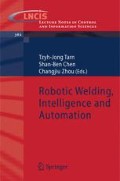Abstract
Existing modeling frameworks for manufacturing control can be classified into hierarchical framework and heterarchical framework. The two modeling frameworks have some drawbacks which can’t be overcome only depending on them. In this paper, in order to improve the performance of the laser welding flexible manufacturing system (LWFMS) we have developed a hybrid modeling framework which has the features of the hierarchical and the heterarchical framework. The LWFMS contains several robots and many workstations which work together to realize a common goal. There exists coordination and cooperation among the different robots and workstations so the multi-agent technology is adopted in the LWFMS. In the end, the simulation result of the hybrid control framework in the LWFMS testifies the validity of the model
Access this chapter
Tax calculation will be finalised at checkout
Purchases are for personal use only
Preview
Unable to display preview. Download preview PDF.
References
Alessandro Garcia, Uirá Kulesza, and Carlos Lucena Aspectizing, “Multi-agent Systems: From Architecture to Implementation,” Lecture Notes in Computer Science, Vol. 3390, PP121–143, 2005
A. Garcia et al, “Separation of Concerns in Multi-Agent Systems: An Empirical Study,” Software Engineering for Multi-Agent Systems II., Springer, LNCS 2940, April 2004.
A. Pace et al, “Assisting the Development of Aspect-based MAS using the SmartWeaver Approach,” Software Engineering for Large-Scale MASs., LNCS 2603, March 2003.
W.B. Lee, H.C.W. Lau, “Multi-agent modeling of dispersed manufacturing networks,” expert systems with applications, vol. 16, no 3,pp 297–306, 1999
N.K. Krothapalli, A.V. Deshmukh, “Design of negotiation protocols for multi-agent manufacturing,” int, J. Prod. Res, vol. 37, no. 7, pp 1601–1624, 1999
H. Van Parunak, “Distributed A.1 and Manufacturing Control: some issues and insights,” Y. Demazeau and J. Muller, eds., Decentralized A.1, North-Holland, pp. 81–104, 1990.
H. Van Parunak, “Industrial applications of multi agent systems,” Actes de MFAUTOM’93, du traitementreparti aux systemes multi-agents et a l’autonomie dessystemes., pp. 18–19, Toulouse, 1993.
Carlos Ramos, “An architecture and a negotiation protocol for the dynamic scheduling of manufacturing systems,” IEEE International Conference on Robotics and Automation, Vol. 4, pp. 8–13, 1994.
H.-J. Wamecke, M. Hiiser, The Fractal Company — A Revolution in Corporate Culture, Springer, Berlin, 1995.
F. Maturana, W. Shen, and D. H. Norrie, “Metamorph: An adaptiveagent-based architecture for intelligent manufacturing,” Int. J. Prod.Res., vol. 37, no. 10, pp. 2159–2173, 1999.
Laws AG, Taleb-Bendiab A, Wade SJ, “Towards a viable reference architecture for multi-agent supported holonic manufacturing systems,” J Appl Syst Stud 2(1):61–81, 2001
Kotak D, Wu S, Fleetwoood M et al, “Agent-based holonic design and operations environment for distributed manufacturing,” Comp Ind 52(1):95–108, 2003
Bellifemine F, Poggi A, Rimassa G, “JADE a FIPA2000 compliant agent development environment,” Proceedings of the international conference of autonomous agents, Montreal, pp 216–217, 2001
A. D. Baker, H. V. D. Parunak, and K. Krol, “Manufacturing over the internet and into your living room: Perspectives from the AARIA Project,” ECECS Dept., Univ. Cincinnati, Cincinnati, OH, Tech. Rep.TR208-08-27, 1997.
N. R. Jennings, M. j. Wooldridge, “Applications of intelligent Agents. In “Agent Technology: Foundations, Applications and Market” Springer, pp. 3–28.1998
W. Cao, C.G. Bian, O.O. Ugwu, L. Newnbam, A. Thorpe, “Collaborative design of structures using intelligent agents,” Automation in construction, vol. 1, pp. 89–103, 2002
Sunderesh S. HERAGU, Robert J. Graves, Byung-In Kim, Art, St. Onge, “Intelligent Agent Based Framework for Manufacturing Systems Control,” IEEE transactions on systems, man and cybernetics pp560–573, Sept. 2002
Author information
Authors and Affiliations
Editor information
Editors and Affiliations
Rights and permissions
Copyright information
© 2007 Springer-Verlag Berlin Heidelberg
About this chapter
Cite this chapter
Gao, S., Zhao, M., Zhang, L., Zou, Y. (2007). Multi-agent-Based Control Model of Laser Welding Flexible Manufacturing System. In: Tarn, TJ., Chen, SB., Zhou, C. (eds) Robotic Welding, Intelligence and Automation. Lecture Notes in Control and Information Sciences, vol 362. Springer, Berlin, Heidelberg. https://doi.org/10.1007/978-3-540-73374-4_28
Download citation
DOI: https://doi.org/10.1007/978-3-540-73374-4_28
Publisher Name: Springer, Berlin, Heidelberg
Print ISBN: 978-3-540-73373-7
Online ISBN: 978-3-540-73374-4
eBook Packages: EngineeringEngineering (R0)

